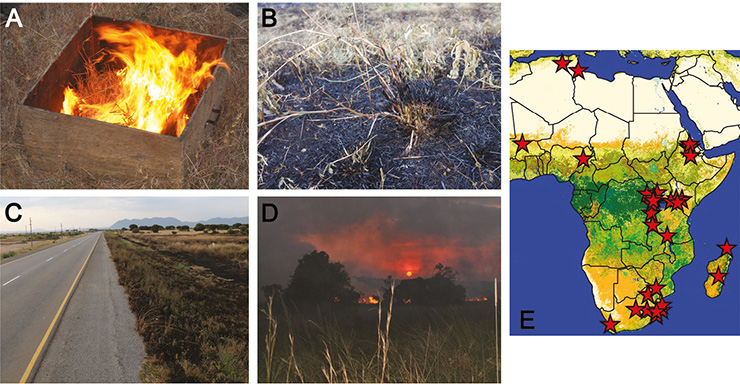- Home
- Publications
- PAGES Magazine
- African Fire Histories and Fire Ecologies
African fire histories and fire ecologies
Courtney-Mustaphi CJ, Colombaroli D, Vannière B, Adolf C, Bremond L, Aleman J & Global Paleofire Working Group (GPWG2)
Past Global Changes Magazine
26(2)
88
2018
Colin J. Courtney-Mustaphi1,2,3, D. Colombaroli4,5, B. Vannière6, C. Adolf7, L. Bremond8,9, J. Aleman10 and the Global Paleofire Working Group (GPWG2)
Nairobi, Kenya, 19-22 July 2018
Patterns of fire are changing across African savannahs, rainforests, fynbos, woodlands, and Afroalpine and montane forests, with direct environmental and socio-ecological consequences. Fire variability has implications for biodiversity (Beale et al. 2018), vegetation patterns, grazing quality, carbon emissions, protected area management, and landscape heterogeneity.
Fire is a crucial component of savannah functioning and structure and is essential for maintaining its biodiversity. Long-term records are key to understanding drivers of fire variability and contextualize recent and ongoing land-use changes that altered fire responses to climate and vegetation changes (e.g. Ekblom and Gillson 2010, Colombaroli et al. 2014). As indigenous forest loss continues and modification through selective harvesting and land-use encroachment accelerate forest changes, the importance of historical disturbance regimes is increasingly relevant for assessing past ranges of variability and to define management targets that support more resilient socioecological systems (Whitlock et al. 2018). But how can the research community engage and integrate with land-management practitioners and policy developers? And how can we promote knowledge transfer and collaborative capacity between the international community and the next generation of African scientists?
 |
|
Figure 1: (A) Experiments, like this 1x1 m controlled grass burning, help relate vegetation-fire-charcoal proxy measurements to paleoecological charcoal records. (B) Residual culms and mainstems from grazing and burning that will regrow leaves and inflorescence. (C) Roads and linear infrastructure increase fragmentation altering spatial complexity for fires. (D) Grass and woody fuels burning near Klein’s Camp, Serengeti National Park, Tanzania, 16 July 2016. (E) Published charcoal records that participants identified during a literature review, including records absent from the Global Charcoal Database (Map source: due.esrin.esa.int/page_globcover.php). Photographs: Colin Courtney-Mustaphi. |
Such themes were explored and discussed during a GPWG2 workshop following the African Quaternary Association (AFQUA) conference. The workshop gathered 18 participants from 12 countries, including 10 researchers from Africa-based institutions. It opened with introductory lectures and laboratory practical courses on study-site selection, sampling techniques, laboratory preparation and charcoal morphology analyses, and a discussion on charcoal calibration approaches for African sites (Ekblom and Gillson 2010; Adolf et al. 2018; Hawthorne et al. 2018; Fig. 1). Participants were introduced to quantitative paleoenvironmental data analysis techniques using R; those included reconstructing savannah fire responses to precipitation and biomass using Generalized Additive Models (GAMs) with data from Lake Naivasha, Kenya (Colombaroli et al. 2014). Dedicated breakout sessions involved data mining using the Global Charcoal Database (GCD) and examinations of spatiotemporal knowledge gaps, notably for western and central Africa, where spatial coverage is scant and several published records need to be imported in the GCD (Fig. 1e). The data gaps are also apparent from the driest and wettest ends of the precipitation gradient, and mostly lacking from mangrove, Afroalpine, and dry woodland study sites. Furthermore, only a limited number of study sites are located near archaeological sites, limiting analyses on human-environment interactions (Marchant et al. 2018). The discussion highlighted the need to develop high-quality charcoal series that account for potential biases in sediment accumulation and related chronological uncertainties (Colombaroli et al. 2014).
Finally, participants discussed the contribution of paleofire data to land-management applications (Fig. 1), including conservation and fire policy; a theme specifically addressed by the GPWG DiverseK framework-workshop (see Colombaroli et al., this issue). Participants were assigned sub-regions and discussed challenges and alternatives for managing fire as a component in socio-ecological systems (Whitlock et al. 2018). The discussion highlighted how resource management in the Menengai Forest, Kenya, and areas of southwest Madagascar are impacted by logging, unauthorized burning, resource extraction, and invasive species; while in the Bale Mountain National Park, Ethiopia, the existing contestation between pastoralists and conservation requirements necessitates new approaches to maintain ecosystem services and promote co-benefits. Approaches combining paleoecology and qualitative, local content optimize bidirectional knowledge transfers and encourage long-term engagement between the GPWG2 and new active members of the research community.
affiliations
1Department of Environmental Sciences, University of Basel, Switzerland
2Department of Archaeology and Ancient History, Uppsala University, Sweden
3Environment Department, University of York, UK
4Department of Geography, Royal Holloway University of London, UK
5Institute of Plant Sciences, University of Bern, Switzerland
6CNRS-UMR Chrono-environnement, Université Bourgogne Franche-Comté, Besançon, France
7Department of Zoology, University of Oxford, UK
8Institut des Sciences de l'Evolution de Montpellier (CNRS, IRD, EPHE), Université de Montpellier, France
9École Pratique des Hautes Études, PSL Research University, Paris, France
10Département de Géographie, Université de Montréal, Canada
contact
Colin J. Courtney-Mustaphi: colin.courtney-mustaphi unibas.ch (colin[dot]courtney-mustaphi[at]unibas[dot]ch)
unibas.ch (colin[dot]courtney-mustaphi[at]unibas[dot]ch)
references
Adolf C et al. (2018) Glob Ecol Biogeog 27: 199-212
Beale C et al. (2018) Ecol Lett 21: 557-567
Colombaroli D et al. (2014) Glob Change Bio 20: 2903-2914
Ekblom A, Gillson L (2010) Holocene 20: 1063-1077
Hawthorne D et al. (2018) Quat Int 488: 3-17
